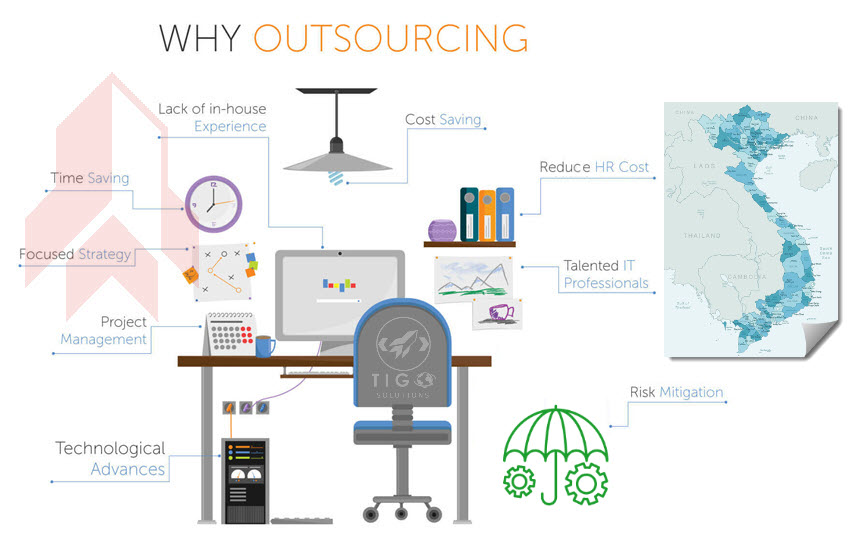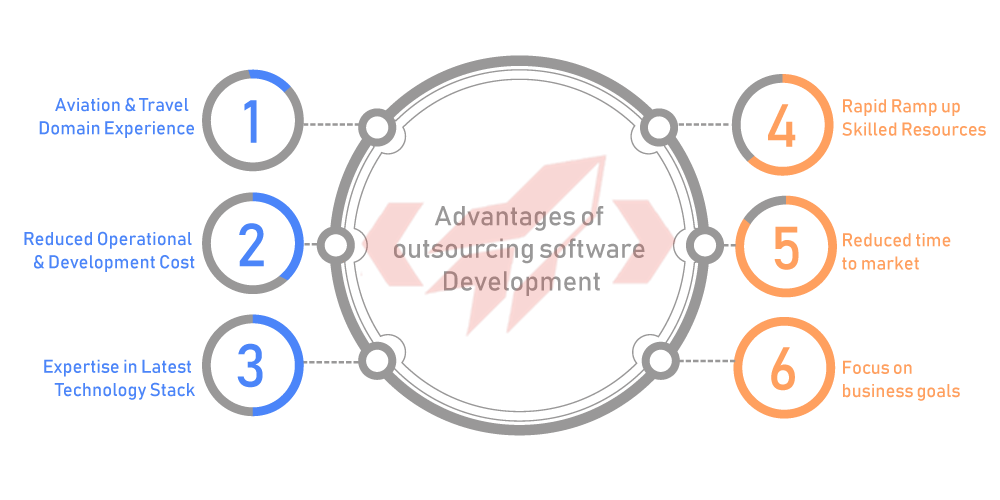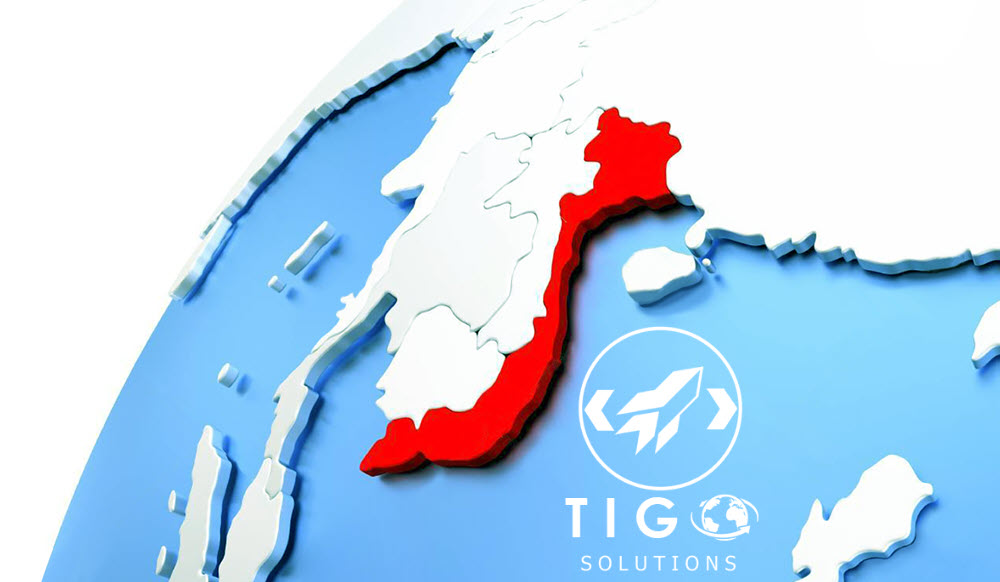Best Practices for Outsourcing Software Projects
Whether it's for workflow automation, streamlining accounting business, or improving sales revenue with customer relationship management (CRM), software keeps operations running smoothly. While there are numerous products, you must ultimately choose between in-house developed software (homegrown solutions) or commercial packages (include the outsourced solutions).

The IT outsourcing industry is thriving!
Nearly a third of companies outsourced IT services, and 78% feel good about their outsourcing arrangements. Where outsourcing was once just a cost-cutting measure, vendors today provide much more than just cheap labor.
To get the best bang for your buck, here are ten best practices you should follow when outsourcing software projects.
1. Determine If Your Project is Right for Outsourcing
Not all projects can be outsourced.

Outsourcing works best when your project has specific requirements, or is unrelated to your core business.
For example, many companies turn to cloud services like Google Cloud and Amazon Web Services to host their websites. The company may excel in building web applications, but don't have the resources to manage a hosting environment.
Instead, they hire cloud service providers to provide and maintain the infrastructure for them. They get the benefit of a professionally maintained environment without the cost of maintaining their own systems.
Outsourcing should leave your team free to focus on what they do best, while also allowing you to deliver your project faster.
2. Make a Plan
Don't just decide on what you're outsourcing, but why you're outsourcing.
Create clear, realistic objectives with well-defined timelines. This gives you more control over your project. It also allows vendors to create realistic, well-defined proposals.
The more information you have, the easier it is to estimate the size and cost of the project. And by creating a good plan at the start, you always have something to refer back to if the project goes off course.
3. Choose A Provider You Can Trust
Your outsourcing provider is an extension of your company. Choose someone you feel comfortable sharing business and trade secrets with, or the project won't progress.
As a baseline, choose a provider that understands your industry. They should also fully aligned with your objectives and business culture. The more they understand your needs, the smoother the project will go.
If you're still not sure, consider launching a small test project. This lets you work together without putting your main project at risk.
4. Get a Dedicated Team

For large, long-term projects, having dedicated resources is important.
A lot of providers charge using the Time & Material model. The problem with T&M is that the provider can shift developers onto different tasks based on availability. This is great for the provider, but it means the team is constantly changing.
Constantly bringing new developers up to speed is both time-consuming and expensive.
Dedicated teams give you a consistent team for the project's lifetime. While initially more expensive, you save money in training and onboarding costs. Developers only need to be introduced to the project once. The result is a team that understands your project from the very beginning.
5. Go Agile
Agile development is the leading method of software development. 71% of organizations use agile, and agile projects are 28% more successful than traditional projects.
Agile development is done in multiple short iterations. Each iteration only lasts a few weeks and involves creating, testing, and releasing new versions. Compare this to traditional development, where a new release could take several months.
Agile lets you implement new changes with greater flexibility and speed. Companies as big as Microsoft have found success with agile in everything from small projects to enterprise-level projects. And despite its flexibility, many vendors offer agile at a fixed cost.

6. Don't Base Your Decision Just on Price
As an outsourcing vendor, we lower the project price based on the followings: Developing the core technology platform for the new system with minimum viable features, while assuring the long-term objectives of reusability, scalability and maintainability. Be assure that the much-needed features are included with the modern Web design and intuitive User Interface, while the relevant and frequently used functionalities are highly prioritized to maximize the efficient usage. However, this also means that many unnecessary features might not need right away, including those which are not effective immediately within 2 years after going live. Such features only will work when there are thousands of active users to interact with system on the daily basis or when there is already a huge data storage to serve. In addition, features which are "nice-to-have" or "could have" or even "To-be Determined" will be excluded in this version due to over-budgeting. Last but not least, low price doesn't mean low quality. It is the cost-effective strategy for "grade" instead of "best quality" or "full-fledged" product. Often time, "less is more" is the wisdom strategy.
The key is to find a vendor that's less expensive than an in-house team, but offers the same level of expertise and service. That can be a hard balance to find, but remember: you get what you pay for.
A lot of experienced outsourcers recommend creating a list of bids, then throwing out the lowest priced and the highest priced. Then, choose from the remaining options according to your budget, requirements, and expectations.
7. Outsource R&D
Many companies do research and development in-house to maintain ownership over their intellectual property. But R&D is hard, and without the right resources, companies can spend more time and money on research than they do on building the final product.
Outsourced R&D provides companies with the tools, technologies, and expertise needed to get to market faster.
8. Document Everything
Documentation is key to tracking the state and progress of your project.
Documentation starts at the very beginning from the initial project plan. Document each stage of your outsourcing venture including deliverables, revisions, changes to the project plan, and updates. This helps you track your progress and gives you the information needed to maintain the project after the end of the contract.
Documentation doesn't take a specific form. It includes emails, meeting notes, manuals, bug tracker submissions, and even code comments. The important thing is to have a record of what was done on the project and when it was performed.
9. Communicate Clearly
Nothing is more disastrous to a collaborative effort than not communicating. Communication keeps both parties engaged and aware of updates to the project.
This can be hard when outsourcing, especially if both teams are in different countries. Language, culture, and time differences all have an effect on communication. However, the project's success depends entirely on communicating. Roadblocks, development problems, and requirement changes can have devastating effects on a project if not communicated quickly and clearly.
With the tools and technologies available today, there's no reason for teams to not communicate. If you can't schedule a face-to-face meeting, make a phone call, send an email, set up a chat room, or use a web-based messaging tool. No matter how you do it, keep collaborating.
10. Own Your Project
Even though another company is working on it, this is still your project. Treat it as if it was being done in-house.
Constantly follow your outsourcing team. Use tools like JIRA, RedMine, Trello, and Slack to track changes, updates, objectives, and comments from the team. Review deliverables frequently, and don't hesitate to contact the vendor with concerns. You're still a manager of your project.
That being said, you don't need to micromanage your vendor. That's their job. However, you do need to keep them on the right track.
Why Outsource to Vietnam?
Vietnam is an emerging country with cheap labor and super talented work force. Its area is a bit larger than UK with population 1.5 times that of UK. Simply put, Vietnam is about to step into "golden population" era with highly trained and skilled engineers - those will re-shape the country and area in next decade. Most Vietnamese people are atheist and traditional culture is not that complicated. People are friendly and love the peace, especially pay respects to the success people and love the Western culture. That's why we're always striving for learning English and enjoying the Western holidays (Christmas, Halloween...) as a way to learn more about the world.


Outsource to Vietnam? Offshore development includes software, web design, website, application testing and more. Outsourcing software development is the driving economic force of many emerging countries. India and China are well recognized as the industry leaders for outsourcing software development. Despite their huge market share in offshore development, Vietnam is quickly emerging as a software outsourcing destination.
Outsourcing to Vietnam is gaining recognition as a low cost quality software maker in Asia. CIO magazine suggests that to outsource to Vietnam is about 90% cheaper than developing software in the United States of America. Compared to India, developing software in Vietnam costs between one third and one seventh times cheaper. These are very convincing figures for companies to start venturing their offshore development to Vietnam.

Companies have started to capitalize this great opportunity of outsourcing to Vietnam with low cost and exceptional quality. Vietnam is on its way to write a new chapter in the history of outsourcing software development. The world will be watching this new revolution in offshore development happening in Vietnam. As an emerging software outsourcing destination, Vietnam will be a perfect fit for companies looking for a technological advance without having to spend a lot of money.
More importantly, Vietnam is a peaceful country with beautiful landscapes (Ha Long bay, Sapa, Hoi An, Da Nang...). You can travel and visit for business trip without hassle.





If you're still not sure whether to outsource, contact us at info@tigosolutions.com.
